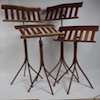I have 5" thick slab of walnut 6' long, bark on, that I've had for a few years. It has not been planed since I had it kiln dried. It measures almost 2' at its widest point. The sawmill I work with does not have a planer that big.
What would be the ideal hand plane to flatten this slab so I can make a coffee table out of it?
I have 2 others similar in size so I don't mind paying for a very good one.




 Reply With Quote
Reply With Quote






